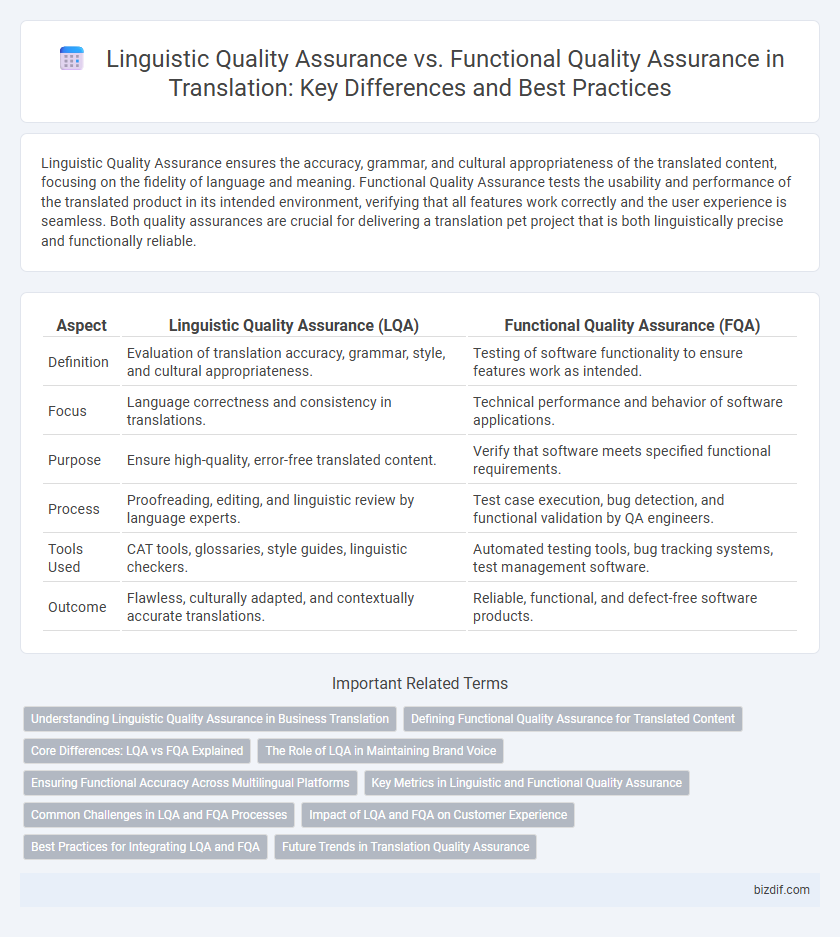Linguistic Quality Assurance ensures the accuracy, grammar, and cultural appropriateness of the translated content, focusing on the fidelity of language and meaning. Functional Quality Assurance tests the usability and performance of the translated product in its intended environment, verifying that all features work correctly and the user experience is seamless. Both quality assurances are crucial for delivering a translation pet project that is both linguistically precise and functionally reliable.
Table of Comparison
| Aspect | Linguistic Quality Assurance (LQA) | Functional Quality Assurance (FQA) |
|---|---|---|
| Definition | Evaluation of translation accuracy, grammar, style, and cultural appropriateness. | Testing of software functionality to ensure features work as intended. |
| Focus | Language correctness and consistency in translations. | Technical performance and behavior of software applications. |
| Purpose | Ensure high-quality, error-free translated content. | Verify that software meets specified functional requirements. |
| Process | Proofreading, editing, and linguistic review by language experts. | Test case execution, bug detection, and functional validation by QA engineers. |
| Tools Used | CAT tools, glossaries, style guides, linguistic checkers. | Automated testing tools, bug tracking systems, test management software. |
| Outcome | Flawless, culturally adapted, and contextually accurate translations. | Reliable, functional, and defect-free software products. |
Understanding Linguistic Quality Assurance in Business Translation
Linguistic Quality Assurance (LQA) in business translation ensures accuracy, consistency, and cultural relevance of translated content, aligning terminology and style with brand voice. This process involves detailed reviews by native-speaking linguists who detect errors in grammar, syntax, and meaning, critical for maintaining professional communication. Unlike Functional Quality Assurance, which tests software performance, LQA focuses solely on the linguistic integrity essential for global market success.
Defining Functional Quality Assurance for Translated Content
Functional Quality Assurance for translated content involves verifying that the localized product performs correctly and meets intended usability standards across all target languages and platforms. It includes testing software interfaces, hyperlinks, multimedia elements, and interactive features to ensure they function seamlessly after translation. This process complements Linguistic Quality Assurance, which focuses on accuracy and fluency of the language itself.
Core Differences: LQA vs FQA Explained
Linguistic Quality Assurance (LQA) focuses on the accuracy, fluency, and cultural appropriateness of translated content, ensuring that language nuances and terminology align with target audience expectations. Functional Quality Assurance (FQA) evaluates the operational aspects of localized products, verifying that translations work correctly within software, apps, or websites without breaking functionality. The core difference lies in LQA addressing linguistic correctness while FQA concentrates on the functional integrity of localized deliverables.
The Role of LQA in Maintaining Brand Voice
Linguistic Quality Assurance (LQA) plays a critical role in maintaining brand voice by ensuring translations accurately reflect the tone, style, and terminology consistent with the brand's identity across all languages. Unlike Functional Quality Assurance (FQA), which focuses on technical performance and usability, LQA evaluates linguistic accuracy, cultural relevance, and adherence to brand guidelines. Effective LQA processes prevent miscommunication and preserve brand integrity, enhancing customer trust and global market appeal.
Ensuring Functional Accuracy Across Multilingual Platforms
Linguistic Quality Assurance (LQA) ensures textual accuracy, cultural relevance, and proper localization within multilingual content, focusing on grammar, syntax, and style consistency. Functional Quality Assurance (Functional QA) verifies that multilingual platforms perform correctly, ensuring all features, buttons, and workflows function seamlessly across different language versions. Combining LQA with Functional QA guarantees both linguistic precision and operational functionality, resulting in a flawless user experience on global digital platforms.
Key Metrics in Linguistic and Functional Quality Assurance
Linguistic Quality Assurance (LQA) metrics focus on accuracy, fluency, terminology consistency, and cultural appropriateness, ensuring that translations meet language-specific standards and client requirements. Functional Quality Assurance (FQA) metrics emphasize usability, functionality, interface integration, and error-free performance, verifying that localized software or content operates correctly within the target environment. Monitoring key metrics such as error rates in LQA and bug detection rates in FQA enables comprehensive quality evaluation for successful localization projects.
Common Challenges in LQA and FQA Processes
Linguistic Quality Assurance (LQA) and Functional Quality Assurance (FQA) both face common challenges such as ambiguity in source content, inconsistent terminology, and varying cultural nuances impacting translation accuracy. LQA struggles with maintaining semantic fidelity and contextual relevance, while FQA often contends with functional mismatches and software localization errors affecting usability. Both processes demand rigorous testing, clear guidelines, and collaboration between linguistic experts and developers to ensure high-quality, user-centric translation outcomes.
Impact of LQA and FQA on Customer Experience
Linguistic Quality Assurance (LQA) ensures translations are accurate, culturally appropriate, and contextually relevant, significantly enhancing user comprehension and brand trust. Functional Quality Assurance (FQA) verifies that the translated content operates correctly within software or platforms, preventing technical issues that disrupt user interaction. Together, LQA and FQA optimize customer experience by delivering both linguistically precise and seamlessly functioning localized products.
Best Practices for Integrating LQA and FQA
Integrating Linguistic Quality Assurance (LQA) and Functional Quality Assurance (FQA) enhances overall translation accuracy by addressing both language fidelity and software functionality. Best practices involve simultaneous testing to identify linguistic errors alongside functional bugs, ensuring user interface consistency and optimal localization performance. Utilizing collaborative tools and workflows that synchronize LQA and FQA processes streamlines issue resolution and maintains high-quality multilingual user experiences.
Future Trends in Translation Quality Assurance
Future trends in Translation Quality Assurance emphasize the integration of Artificial Intelligence and machine learning to enhance both Linguistic Quality Assurance (LQA) and Functional Quality Assurance (FQA) processes. Advanced algorithms will increasingly detect nuanced linguistic errors and context-specific issues, while automated functional testing tools ensure localized software operates correctly across diverse languages and regions. These innovations aim to streamline workflows, reduce human error, and elevate the overall accuracy and consistency of multilingual content.
Linguistic Quality Assurance vs Functional Quality Assurance Infographic

 bizdif.com
bizdif.com